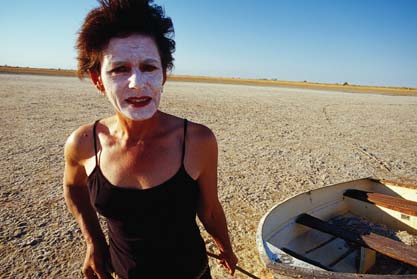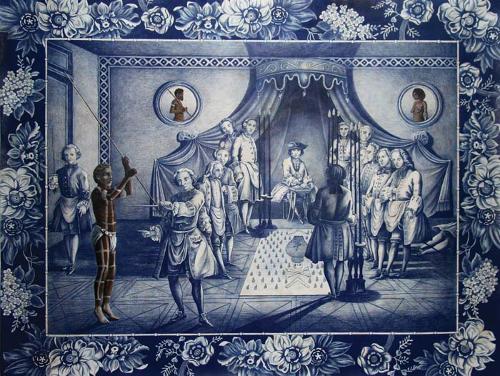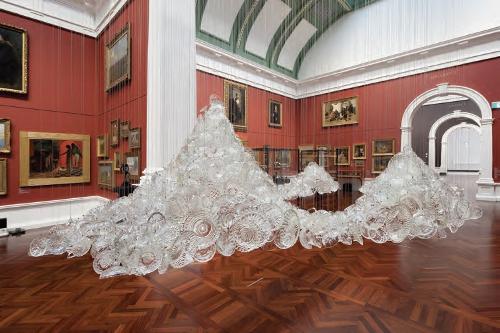
In a creative alliance over 15 years Pamela Lofts and Kim Mahood travelled into the Tanami Desert, a vast area of sandy plains, low-lying vegetation, low hills, rocky ridges and mostly ephemeral waters, north- west of Alice Springs.
Obscured by Light arose from these travels although it was not their express purpose. The process was less defined, more exploratory than that, and other work from both artists emerged first. For Mahood, crucially, this included her award-winning memoir, Craft for a Dry Lake (2000), which positioned her as a writer and sank her artistic roots deep into the Tanami where she had grown up on a cattle station. The memorable photograph for the front cover was taken by Lofts, introducing to a wide audience some elements of the character and key imagery of this exhibition.
Other elements were developed by Lofts in her photographic series Threshold (mightbe somewhere) and video work, Ripple Affect, shown together in Requiem for Another (2009), lamenting the lost ways of life of the desert's original inhabitants, the lost possibilities of a different kind of settlement.
What particularly distinguishes the present work is the satiric playfulness and humour of the strand that loosely narrates the antics of one Violet Sunset, performed by Mahood, created and directed by Lofts. In gorgeous cocktail frock and kitten heels, Violet is the antithesis of the heroic male explorers and cattlemen most often associated with this country. When Australian novelist Kate Grenville opened the show, she referred to the landscape that the artists have made Violet’s stage as the "scary stuff". It was lightly said but even so echoed the popular conception of the Australian interior as a great threatening unknown, 'hard on men and machines’, a conception that this show parodies.
The work is an interplay of text by Mahood and images by Lofts. The text consists of narrative fragments, poetic evocations, and occasionally, and least effectively, statements tending to aphorism. The images, edited from many hundreds, are as gorgeous as the frock - saturated colour, high gloss – and finely attuned to both the drama of the landscape and the story-telling nature of the enterprise. The interplay might have been stronger if the text had been less visually subordinate to the images. And the whole might have more compellingly commanded the gallery space if it had been laid out less like a book.
Nonetheless it drew me in, particularly the less parodic strand, concerned with the traces of other lives and finding them mostly in absence, death and abandonment. This is the terrain of the deserted outstation in Lofts’ Threshold, of Mahood’s elegiac memoir. The paired images of twinned shapes – reminiscent of boats, seed pods, coffins, coolamons – scooped out of the earth, one of them holding a naked female form, show Mahood’s sculptor’s hand and are aesthetically distinct from the rest. The fragment of text positioned with them makes their biographical association explicit: “She would have found it impossible to imagine as a child that one could love a place as she loved this one, and still not be able to remain. That failure has rendered her homeless.”
This place is also haunted by the elusive figure of The Inland Sea. The preoccupation of early explorers has a contemporary form, suggests the work: “The people in the city where she lives believe that answers are to be found in the desert, although none of them have been there. Although she is not confident that this is true, Violet decides that it is worth finding out.” Here we see her marching off across a parched surface marked by camel tracks, trendy travel bag in hand; later possibly expired alongside the skull of a dog; later still, alive but disconsolate, alongside the dessicated carcass of a camel. In between there’s another character, a feminine Fitzcarraldo, who has appeared before dragging her boat around the desert, and now suddenly finds herself afloat, “brimming with purpose, / the mote of a mission beaming / in her eyes”. But this ‘sea’ and purpose soon evaporate.
What can be found in the desert takes actually being there, the work contends, with all the risks of madness, loneliness, fear and hardship as well as the rewards of stillness, spaciousness, beauty and joy. In the final image the ephemeral lake has returned – “Blue as an eye, curling round the rim of the world” – and Violet surrenders to it. “She found it in the end just by being there at the right time.” A fundamental lesson of desert living.












